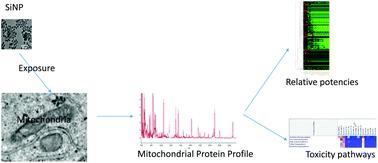Our official English website, www.x-mol.net, welcomes your
feedback! (Note: you will need to create a separate account there.)
In vitro toxicity screening of amorphous silica nanoparticles using mitochondrial fraction exposure followed by MS-based proteomic analysis
Analyst ( IF 3.6 ) Pub Date : 2022-07-18 , DOI: 10.1039/d2an00569g Premkumari Kumarathasan 1, 2 , Nazila Nazemof 2 , Dalibor Breznan 1 , Erica Blais 1 , Hiroyuki Aoki 3 , James Gomes 2 , Renaud Vincent 1 , Sadhna Phanse 3 , Mohan Babu 3
Analyst ( IF 3.6 ) Pub Date : 2022-07-18 , DOI: 10.1039/d2an00569g Premkumari Kumarathasan 1, 2 , Nazila Nazemof 2 , Dalibor Breznan 1 , Erica Blais 1 , Hiroyuki Aoki 3 , James Gomes 2 , Renaud Vincent 1 , Sadhna Phanse 3 , Mohan Babu 3
Affiliation

|
Silica nanoparticles (SiNPs) are used in consumer products, engineering and medical technologies. Attractive properties of SiNPs (e.g. size/surface-modification) enhance usage and thus the likelihood of environmental/human exposures. The assessment of health risks associated with exposures to SiNPs requires information on their relative potencies and toxicity mechanisms. In this work, phagocytic J774 cells were exposed to amorphous pristine (15, 30, 75 nm) and surface-modified (–NH2, –C3COOH, –C11COOH, –PEG) SiNP variants, and internalization was assessed by transmission electron microscopy (TEM), while cellular ATP was measured as a cytotoxicity endpoint. Furthermore, mitochondrial fractions from J774 cells were exposed to these SiNP variants (5, 15 μg mL−1), as well as two reference particles (SiNP 12 nm and TiO2), and proteomic changes were analyzed by mass spectrometry. Ingenuity Pathway Analysis was used to identify toxicity pathways. TEM analyses showed SiNP internalization and distribution along with some changes in mitochondrial structure. SiNP size- and surface-modification and chemical composition-related changes in mitochondrial proteins, including key proteins of the respiratory complex and oxidative stress, were evident based on high content mass spectrometry data. In addition, the dose-related decrease in cellular ATP levels in SiNP-exposed cells was consistent with related mitochondrial protein profiles. These findings suggest that physicochemical properties can be determinants of SiNP exposure-related mitochondrial effects, and mitochondrial exposures combined with proteomic analysis can be valuable as a new approach methodology in the toxicity screening of SiNPs for risk assessment, with added insight into related toxicity mechanisms.
中文翻译:

使用线粒体部分暴露和基于 MS 的蛋白质组学分析对无定形二氧化硅纳米粒子进行体外毒性筛选
二氧化硅纳米粒子 (SiNP) 用于消费品、工程和医疗技术。SiNPs 的有吸引力的特性(例如尺寸/表面改性)提高了使用率,从而提高了环境/人类暴露的可能性。与接触 SiNPs 相关的健康风险评估需要有关其相对效力和毒性机制的信息。在这项工作中,吞噬 J774 细胞暴露于无定形原始(15、30、75 nm)和表面修饰(-NH 2、-C3COOH、-C11COOH、-PEG)SiNP 变体,并通过透射电子显微镜评估内化( TEM),而细胞 ATP 被测量为细胞毒性终点。此外,来自 J774 细胞的线粒体部分暴露于这些 SiNP 变体(5, 15 μg mL -1),以及两个参考粒子(SiNP 12 nm 和 TiO 2),并通过质谱分析蛋白质组学变化。Ingenuity Pathway Analysis 用于识别毒性途径。TEM 分析显示 SiNP 内化和分布以及线粒体结构的一些变化。基于高内涵质谱数据,SiNP 尺寸和表面修饰以及线粒体蛋白(包括呼吸复合物和氧化应激的关键蛋白)中的化学成分相关变化是显而易见的。此外,SiNP 暴露细胞中细胞 ATP 水平的剂量相关降低与相关的线粒体蛋白谱一致。这些发现表明,物理化学性质可能是 SiNP 暴露相关线粒体效应的决定因素,
更新日期:2022-07-18
中文翻译:

使用线粒体部分暴露和基于 MS 的蛋白质组学分析对无定形二氧化硅纳米粒子进行体外毒性筛选
二氧化硅纳米粒子 (SiNP) 用于消费品、工程和医疗技术。SiNPs 的有吸引力的特性(例如尺寸/表面改性)提高了使用率,从而提高了环境/人类暴露的可能性。与接触 SiNPs 相关的健康风险评估需要有关其相对效力和毒性机制的信息。在这项工作中,吞噬 J774 细胞暴露于无定形原始(15、30、75 nm)和表面修饰(-NH 2、-C3COOH、-C11COOH、-PEG)SiNP 变体,并通过透射电子显微镜评估内化( TEM),而细胞 ATP 被测量为细胞毒性终点。此外,来自 J774 细胞的线粒体部分暴露于这些 SiNP 变体(5, 15 μg mL -1),以及两个参考粒子(SiNP 12 nm 和 TiO 2),并通过质谱分析蛋白质组学变化。Ingenuity Pathway Analysis 用于识别毒性途径。TEM 分析显示 SiNP 内化和分布以及线粒体结构的一些变化。基于高内涵质谱数据,SiNP 尺寸和表面修饰以及线粒体蛋白(包括呼吸复合物和氧化应激的关键蛋白)中的化学成分相关变化是显而易见的。此外,SiNP 暴露细胞中细胞 ATP 水平的剂量相关降低与相关的线粒体蛋白谱一致。这些发现表明,物理化学性质可能是 SiNP 暴露相关线粒体效应的决定因素,











































 京公网安备 11010802027423号
京公网安备 11010802027423号